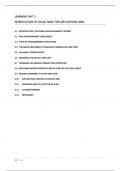Samenvatting
Summary Ain3701 b0 ls
- Vak
- Instelling
3.1 INTRODUCTION, OUTCOME AND ASSESSMENT CRITERIA In learning unit 1, you learnt to apply computational thinking to business problems. Learning unit 2 covered a more theoretical approach to automation by making use of RPA and robotics. The purpose of learning unit 3 and learning unit 4 is to tea...
[Meer zien]




